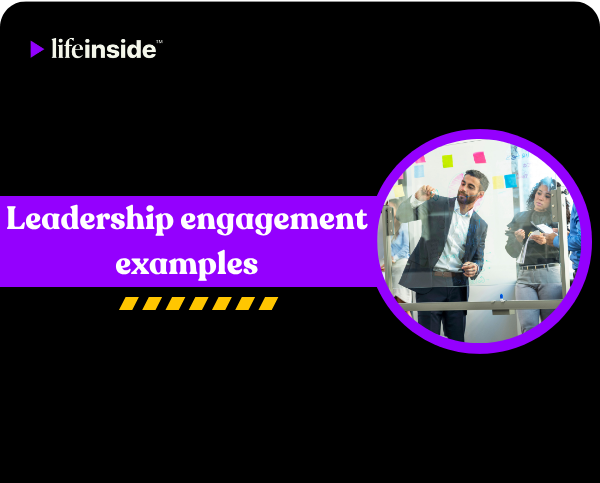Want your team to connect, be inspired, and motivate themselves to produce their best work?
These things don’t just happen by themselves. They require great leaders to make them work. How you lead your team impacts not just their productivity, but their long-term loyalty to your organisation.
So, in this post, we’ll discuss some powerful leadership engagement examples that you can use to inspire your teams!
Why Leadership Engagement Matters
Being a leader isn’t just about giving your team a set of instructions—it’s also about showing up when needed and listening to their issues.
According to a report by Catalyst, 76% of employees who stated that their manager was empathetic were also more productive and engaged at work. This statistic highlights the importance of leadership in creating motivated teams.
When you meaningfully engage with your employees, you set the standard for a high-performing work culture. People want to work for leaders who show their human side, instead of treating their employees as just cogs on the wheel.
Impact on Employee Morale
As a leader, you’ll set the emotional tone for the organization. If you’re disengaged, rarely present to understand the employees’ pain points, and only care about results (not how they’re achieved), your team will likely be disengaged and low on morale. This affects their long-term productivity, and they’ll likely search for better opportunities.
But when you’re present, solution-oriented, and empathetic towards their issues, you create a positive environment at the workplace. Your team knows that you have their back, and this can make all the difference in the world.
Influence on Organizational Performance
Coming back to the idea of productivity, a Gallup report found that employees who are engaged at the workplace added 21% to the company’s profitability. It also led to a 17% increase in the company’s output.
These aren’t rookie numbers—that’s a sizeable increase in both fronts, whether you’re running an enterprise or a small business.
You can be sure that if your employees are disengaged, it won’t be long before their output drops. This, in turn, will directly hurt your company’s profitability and productivity.
Connection Between Engagement and Retention
Consider this:
If you’re in an unhappy relationship with your partner, you’ll try to leave the relationship in search of something better, or for peace of mind.
Work relationships with leaders, or the organization in general, work similarly. Employees who are unhappy often search for better opportunities elsewhere. This leads to lower retention rates, and the company has the bear the costs for hiring and filling multiple empty positions.
However, keeping an employee engaged costs much less than finding a replacement. So, if your attrition rates are high, you need to get back to the ground level to find out what needs improvement in employee engagement.
Top Leadership Engagement Examples
Now that you know about the impact leadership engagement has on the workforce, let’s take a look at some excellent examples that showcase the effect of great leadership.
1. Regular 1-on-1 Check-ins
Having regular 1-on-1 check-ins with your employees shows a personal and empathetic touch. When you have multiple employees, many of them might feel overlooked. However, with 1-on-1 check-ins, you give them the signal that their voices matter.
It’s also a great way to find out any roadblocks, personal challenges impacting work productivity, work updates, and project progress.
Example from Google’s People Operations
Google trains its management to conduct 1-on-1 check-ins with employees and help them advance their careers. They provide a more holistic approach to these meetings, instead of focusing on just project updates.
2. Transparent Goal Sharing
Employees want to feel like their work matters and is important for reaching company objectives. As a leader, if you clearly explain the company’s goals to your team, then they’re aware of how their work contributes to the larger scheme of things.
How Microsoft Aligns Leaders and Teams
Microsoft ensures that both leaders and their teams are aware of each other's objectives. Sharing OKRs (Objectives and Key Results) isn’t a one-way street—employees share their OKRs with leaders, and leaders share theirs with everyone in the team.
This makes everyone feel part of the same cohort and working together to achieve the organization’s goals.
3. Public Recognition of Achievements
It’s essential to celebrate your employees’ wins. When you publicly recognize their achievements, employees understand that their work is important for the company. This leads to higher productivity, which can increase your brand’s profitability.
Using Internal Platforms like Slack
Any company intranet platform works for this. If you’re using Slack, you can mention the employee and their achievement in the organizational group. A simple “Excellent work on the client’s requests!” can go a long way in keeping your employees engaged.
4. Involving Teams in Decision-making
While leaders always have the final say, you need to take your team’s perspectives and opinions into account as well. It’s not just about optics—your team members are working at the ground level for the project and might be aware of what’s the need of the hour. This ensures that you’re keeping your team in the loop and listening to them, before making a final decision.
Collaborative Strategy Sessions
Set up a meeting on Zoom or Google Meet with your team to discuss strategy. Ensure that it’s two-way communication, not just the leader presenting their case and ordering their team to follow.
These sessions can give you valuable insight from employees on how to proceed. Moreover, employees are more engaged because they understand their importance.
5. Active Listening and Feedback Loops
Feedback shouldn’t just flow from leaders to employees. As a leader, you need to be open to feedback from your team as well. This signals to the employees that the leadership and management care about continuous improvement in all sectors of the organization.
Real Case: IBM’s Feedback Culture
A great example of this is IBM’s “CheckPoint” system. This creates a feedback loop where not only can the managers give feedback, but the employees can provide their thoughts on leadership as well. Employees feel that their opinions are heard, and leaders can make informed decisions.
6. Personalized Career Growth Support
If you can provide a realistic vision to your employees about their career growth in your organization, you can engage and motivate them further. It’s not just about training—you should provide career development support in terms of courses and networking opportunities.
Example: Salesforce Development Pathways
Salesforce implements excellent career growth support for its employees through the “Trailhead” platform. It allows leaders to create personalized learning programs for their employees, based on the latter’s strengths and areas of improvement.
They can map their career paths, set personal goals that help both themselves and the organization, and unlock premium memberships for more learning opportunities.
7. Leading by Example
When you’re a leader, you have to lead by example. Talking the talk isn’t as valuable to an employee as walking the walk. Keep yourself accountable, showcase your learning, and embody the company’s core values. These highlight your commitment to the organization’s cause, and inspire employees to follow suit.
When CEOs Embody Company Values
Patagonia, a clothing company famous for its outdoor gear, has a known stance on climate change and sustainability. Its former CEO, Rose Marcario, was a renowned environmental activist who even offered paid time off to her employees if they volunteered for sustainability drives.
She was consistent with her words and actions, which led to greater employee engagement for all company initiatives.
How to Implement Leadership Engagement Practices
Now that you’ve got a fair idea about leadership engagement, let’s see how you can implement these in your organisation.
- Start small. Your leadership engagement process doesn’t have to be massive from the outset. Start with something small, like a weekly check-in meeting or public recognition of employee achievement on your intranet portals. Analyze the feedback, and you can move forward from there.
- Personalize your approach. Engagement practices don’t work in a one-size-fits-all setting. Each team member needs a different approach that’s customized to their needs for maximum engagement and productivity.
- Set an example. Create engagement initiatives by yourself and implement them quickly. Be transparent about your approach. Once employees notice the work you’re putting in, they’ll be inspired to engage.
- Adjust based on progress. You can’t be rigid with your approach. Be open to adjustments on the fly as you progress through your engagement initiatives.
- Scale with the help of other teams. Involve teams like HR or People Ops to ensure that your engagement drives are scaled in a structured manner. Otherwise, it can lead to inconsistency.
Common Mistakes Leaders Make in Engagement
Here are the mistakes you need to avoid when you’re setting up leadership engagement processes for your team:
- Inconsistency: Your engagement drives shouldn’t start strong and then quickly fade away. This gives the impression of a gimmick to your employees. Even if the drives are smaller in scale, maintain your approach and make it a regular practice.
- Forced Engagement: Don’t treat your engagement process like a checkbox that needs to be fulfilled at the end of every quarter. Employees can understand when your initiatives are forced, leading to low motivation.
- Overlooking Certain Employees: Not all employees are the same—some might be quieter than others or introverted. Check up on them regardless; they can provide you with valuable insights.
- Feedback Follow-up: Once you receive feedback from your employees, don’t just sit on it. Try to implement it wherever possible and give regular updates to your members.
- Ignoring Middle Managers: Leadership often focuses just on the reports from their managers. Instead, talk to the managers as well for their input and understanding of the situation. This will give you more data for a holistic approach.
Enhance Leadership Engagement With Life Inside
Life Inside is an interactive video platform that creates, collects, and automates the distribution of interactive videos across all your channels. With interactive videos, you increase direct engagement from employees and create actionable feedback loops to optimize your campaigns.
With our platform, you can turn your leadership engagement plans into authentic moments. From CEOs sharing their vision to behind-the-scenes videos on cross-departmental collaboration, use interactive videos to turn your engagement drive into real, actionable, and relatable moments for other employees.
Sign up for Life Inside today to bring your leadership engagement plans into motion!
Frequently Asked Question:
1. Why is transparent communication important in leadership?
Transparent communication from leaders is essential in providing clarity to your employees. Through this, they know where they stand, what they need to do, and how their actions can help in the company’s growth.
2. How can companies measure leadership engagement success?
To measure leadership engagement success, check the number of people engaging with your processes. This could be the number of attendees for a Townhall, feedback loop implementation, or even engagement on platforms like Slack. You can also analyze data from interactive videos that you create with Life Inside, with metrics for engagement rates, watch times, and interactivity.
3. How can a new manager improve team engagement quickly?
As a new manager, you can have regular check-ins with your employees to understand their progress and pain points. Set up feedback loops and turn them into actionable initiatives for maximum impact. Start small, but be consistent to win the trust of your employees.




